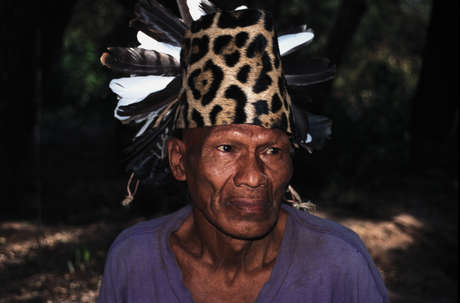Uncontacted Indians in danger
August 31, 2002
This page was created in 2002 and may contain language which is now outdated.
'We don't want to lose our traditional land because our ancestors lived here.'
Gabide, Totobiegosode leader.
The last uncontacted Indians south of the Amazon basin are being squeezed from all sides. With their last refuge gradually being overrun, they have nowhere left to hide. But if the Paraguayan government acts, the Indians can keep hold of their land and avoid the diseases that threaten to decimate their population.
The Indians are members of the 5,000-strong Ayoreo tribe which once occupied much of north Paraguay and south-east Bolivia. This region is part of the Chaco, a sparsely-populated expanse of scrub forest, grasslands and swamp. The Ayoreo are hunter-gatherers, living off the abundant natural resources of their homeland; they hunt wild pigs and armadillo, collect wild honey, and plant squash, corn and beans in the rainy season.
During the last century most of the Ayoreo's land was taken over by outsiders. In Paraguay ranchers cleared the forest of valuable timber, and set up vast cattle ranches. From the 1920s, thousands of European Mennonites established colonies in the Chaco; their ranches and dairy farms in turn attracted land speculators, whose companies now hold title to much of the Ayoreo's territory.
More recent arrivals to the Ayoreo's land are the fundamentalist missionaries of the American New Tribes Mission (NTM). The NTM has tried to convert many Ayoreo, and established a colony at a place called Campo Loro.
In 1979 and 1986 'evangelised' Indians, with the backing of the NTM, went into the forest to bring out uncontacted Ayoreo, from a group known as the Totobiegosode – 'people from the place of the wild pig'. At least five of the 'evangelised' Ayoreo died during these expeditions, as the uncontacted Indians tried to defend themselves from capture. Several of those brought to Campo Loro died soon after through ill-health. Campaigns by Survival and others brought a halt to these 'manhunts'.
An unknown number of Ayoreo-Totobiegosode remain in the forest, actively resisting contact with outsiders. From evidence such as footprints and abandoned huts, there are known to be several distinct family groups living in a wide area.
In 1993, those Ayoreo-Totobiegosode who had been forced out of the forest submitted a land claim to the government on behalf of their relatives still in the forest. With the assistance of a local NGO, the Totobiegosode Support Group, the Indians requested title to, or protection over, 550,000 hectares of their land – less than a fifth of their ancestral territory of 2.8 million hectares.
Since the claim was submitted the government has titled 67,400 hectares to the Indians, with another 116,000 hectares promised. Injunctions have also been placed on the whole 550,000 hectares, preventing landowners, ranchers and other settlers from clearing forest or carrying out any other work on the land. But despite these injunctions, there has recently been a frightening wave of incursions, some of them causing the Totobiegosode in the forest to flee, abandoning their huts, which have been found empty.
In June, bulldozers cleared paths into forest in the south-east of the Indians' territory on land owned by the Veragilma and Falabella companies. The paths were cut to give access to stands of palo santo, a valuable hardwood. At the same time, the authorities in the regional government of Alto Paraguay are pushing for new colonisation of these lands. A huge track has also been bulldozed by Mennonite settlers on an estate called Yvy Pora: this disturbed the Totobiegosode in the area, who fled. Still other paths have been cleared on the Nieto and Gorostiaga ranches in the south and west of the Ayoreo territory.
The Ayoreo-Totobiegosode have been fleeing incursions onto their land for decades, and have made it abundantly clear they do not want contact: in 1994 and 1998 arrows were fired at bulldozers operating on their land. The clearing of their land is illegal – and if it continues, puts the isolated Ayoreo at great danger of being caught up in violent conflicts or again falling victim to disease.

